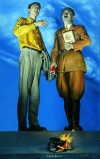Illustration:
ill. 5.40
Author:
Ai Weiwei (1957-) 艾未未
Date:
1986
Genre:
oil painting, triptych
Material:
scan, paper, colour; original source: Triptych in oils,
Source:
Sullivan 1996: Michael, Sullivan. Art and Artists of Twentieth-Century China, Berkeley: University of California Press, 1996: plate 89, insert between p.144/145.
Courtesy:
Ai Weiwei, for the print University of California Press Berkeley
Keywords:
Mao Zedong, Mao portrait, China Avant-Garde, European painting tradition, Mao memories, Ai Weiwei
Ai Weiwei: Untitled (Ai Weiwei: Wuti 艾未未: 无题)

Mao was there, imposingly imposed in reiteration, long before the Cultural Revolution. And he does not disappear as a repetitive symbol, after it ended either, although it may be said, that repetition, multiplication now takes to new grounds. In a work such as Ai Weiwei’s 艾未未 (1957-) untitled triptych—significantly a format that goes back to the Christian art of altar painting—of Mao (1986), composed in grey, black and white oils, Mao appears thrice in the same standard outline in white, before a dark background. The outline (almost a silhouette) looks as if scratched in the first image, is blotted in ink in the last image and faded in the central image. The triptych may be interpreted as a comment on the many scratced, blotted over and fading images of Mao on walls and buildings all over China since the early 1980s and thus muse on retreating memories of Mao as well.












































































































